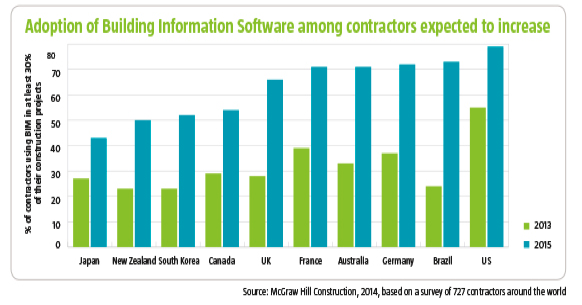With the growing complexity of manufacturing processes and the increasing variety of materials that can be used, design software is becoming increasingly important.
Used in a wide range of industries, from aerospace, automotive, industrial equipment and consumer products, to architecture and construction, 3D computer aided design (CAD), product lifecycle management (PLM) and building information modeling (BIM), these software tools are transforming the world of design, manufacturing and construction.
Though computer aided design tools have long been used by product designers, engineers and architects, their degree of sophistication has vastly improved recently and the transition from 2D to 3D design tools really only took off within the past 10 to 15 years. There is still considerable room for growth: Out of an estimated 5.5 million design engineers employed globally, less than 40 percent are estimated to have made the switch from 2D to 3D modeling.
3D CAD enables engineers, designers and architects to visualize, simulate and test a virtual product during the design process, without the need for physical prototypes. PLM tools, which go beyond the initial product design stage to incorporate manufacturing management, product servicing and disposal into the design process, are also gaining popularity as design and production become increasingly integrated.
Key benefits of 3D CAD and PLM include reduced production costs, collaborative prototyping and greater flexibility. By allowing product engineers to run multiple product simulations simultaneously, 3D modeling software saves time, facilitates cost-benefit analysis and enables the optimization of the materials mix. And the collaborative nature of newer cloud-based 3D design platforms allows multiple users based in different locations to work together on a digital prototype while extending testing and feedback loops to suppliers, manufacturers and end users, allowing for later changes to the product design before committing to an actual manufacturing run.
In the construction space, Building Information Modeling (BIM) enables architects, engineers and contractors to visualize 3D models of buildings and better estimate costs before construction begins. In addition, BIM can incorporate maintenance and operations data to improve environmental and cost efficiency throughout the life-time of the building. The adoption of BIM technology is set to increase in coming years as local governments increasingly mandate the use of BIM in public projects in order to reduce costs and improve efficiency.
A number of software companies are well positioned to benefit from expected growth in the 3D modeling market. Dassault Systèmes and PTC both offer a range of 3D CAD and PLM software. Autodesk, whose AutoCAD range is already popular among architects, is expected to remain a strong player in the BIM space.

Pieter Busscher is lead portfolio manager responsible for the RobecoSAM Smart Materials Strategy and deputy portfolio manager for the RobecoSAM Sustainable Agribusiness Equities Strategy and the RobecoSAM Sustainable Water Strategy.








